

Blogs » SproutCore: JavaScript Applications. Revealed by Apple at the recent WWDC as the basis of the MobileMe web applications, is the newest member of the JavaScript framework fraternity: SproutCore. I’m pretty sure that if I told you SproutCore was yet another JavaScript framework for creating rich browser application interfaces, you’d prefer to scrub your eyeballs with steel wool than keep reading. Don’t head off just yet though, because SproutCore is quite different from other frameworks and worth taking a look at. SproutCore is an open source framework for creating desktop-style applications that run in the browser using only HTML, CSS and JavaScript. You first create your application within a local development environment and then use the SproutCore build tools to compile the application in to a set of static files you can place on your web server. The term ‘thick client’ has been coined by SproutCore’s lead developer, Charles Jolley, to describe SproutCore’s approach.
Here’s a very simple demonstration of how it works. Software Engineering for Ajax - Part 2. Software Engineering for Ajax - Part 2 Ryan Dewsbury Digg This Add to del.icio.us Debugging in Eclipse Eclipse provides a nice environment for debugging a running Java application.
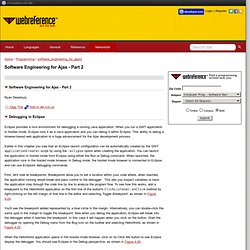
Create an Ajax-based IM client. Our First Ajax Application - webreference.com. [next] Our First Ajax Application By Phil Ballard Digg This Add to del.icio.us This chapter is excerpted from Ajax StarterKit Quick Start Guide, authored by Phil Ballard, published by Sams Publishing, © Copyright 2007 Sams Publishing.

In this lesson you will learn how to construct a complete and working Ajax application using the techniques discussed in previous lessons. Constructing the Ajax Application The previous lessons have introduced all the techniques involved in the design and coding of a complete Ajax application. Our first application will be simple in function, merely returning and displaying the time as read from the server's internal clock; nevertheless it will involve all the basic steps required for any Ajax application: Let's get to it, starting with the HTML file that forms the foundation for our application. The HTML Document Listing 11.1 shows the code for our HTML page.
Learning AJAX. Learning AJAX(Page 1 of 4 ) Please remember, AJAX is not a new programming language, so you don't have to learn anything new.
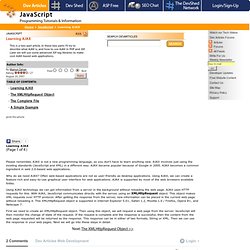
AJAX involves just using the existing standards (JavaScript and XML) in a different way. AJAX became popular because of Google in 2005. AJAX becomes a common ingredient in web 2.0-based web applications. Why do we need AJAX? Using AJAX technology we can get information from a server in the background without reloading the web page. First we need to create an XMLHttpRequest object. Making JavaScript Applications Degrade Gracefully. Making JavaScript Applications Degrade Gracefully(Page 1 of 4 ) Introduction As the enthusiast web developer that you certainly are, quite possibly you'll agree with me that the present and future of JavaScript-driven applications looks really brilliant and promising.
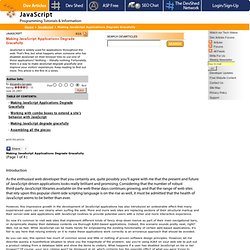
Considering that the number of robust third-party JavaScript libraries available on the web these days continues growing, and that the range of web sites that rely upon this popular client-side scripting language is on the rise as well, it must be admitted that the health of JavaScript seems to be better than ever. However, this impressive growth in the development of JavaScript applications has also introduced an undesirable effect that many experienced users can see clearly when surfing the web.
More and more web sites are replacing sections of their structural markup and their server-side web applications with JavaScript routines to provide potential users with a richer and more interactive experience. Introducing MooTools and MooFX. Introducing MooTools and MooFX(Page 1 of 4 ) MooTools version 1.0 (the current version) was first officially released to the world on March 21, 2007, although it was available and much discussed for some time prior to this.
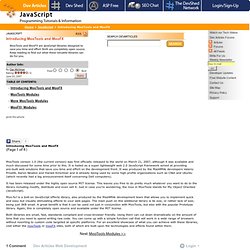
It is hailed as a super lightweight web 2.0 JavaScript framework aimed at providing pre-built web solutions that save you time and effort on the development front. It was produced by the Mad4Milk developers Valerio Proietti, Aaron Newton and Harald Kirschner and is already being used by some high profile organizations such as CNet and Ubuntu (which recently had a big announcement itself concerning Dell computers). It has been released under the highly open source MIT license. This leaves you free to do pretty much whatever you want to do to the library including modify, distribute and even sell it.
Both libraries are small, fast, standards compliant and cross-browser friendly. Introducing MochiKit. Introducing MochiKit(Page 1 of 4 ) The general aim is to make building web content fun and easy and driven by creativity, passion and innovation.
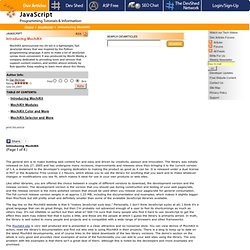
The library was initially released on July 27, 2005 and has undergone many revisions, improvements and releases since then bringing it to the current version of 1.4, a testament to the developer's ongoing dedication to making the product as good as it can be. It is released under a dual license in MIT or the Academic Free License 2.1 flavors, which allows you to use the library for anything that you want and to make whatever changes or modifications you see fit, which makes it ideal for use in your own products or web sites.
Like other libraries, you are offered the choice between a couple of different versions to download, the development version and the release version.